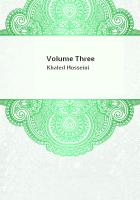It is the market price which decides the ratio of the value of gold to that of silver. The market price is the base of this proportion in the value assigned to coins of gold and silver. If the market price varies considerably, that of the coinage must be reformed to follow the market rate. If this be not done confusion and disorder set in in the circulation, and coins of one or the other metal will be taken above the Mint value. There are an infinity of examples of this in antiquity. There is a quite recent one in England under the regulations made at the London Mint. The ounce of silver, eleven twelfths fine, is worth there 5s 2d sterling. Since the ratio of gold to silver (which had been fixed at 1 to 16 in imitation of Spain) has fallen to 1 to 15 and 1 to 14? the ounce of silver sold at 5s 6d sterling, while the gold guinea continued to circulate at 2 1s 6d sterling, which caused the export from England of all the silver crowns, shillings and sixpences which were not worn by circulation, silver money became so scarce in 1728 (though only the most worn pieces remained) that people had to change a guinea at a loss of nearly 5 per cent. The trouble and confusion thus produced in trade and circulation obliged the Treasury to request the celebrated Sir Isaac Newton, Master, of the Tower Mint, to make a Report on the measures he thought most suitable to remedy this disorder.
There was nothing easier. It was only necessary to follow the market price of silver in coining silver at the Tower. And whereas the ratio of gold to silver was of old time by the laws and regulations of the Tower Mint 1 to 15? it was only necessary to make the silver coins lighter in the proportion of the market price which had fallen below 1 to 15; and, to anticipate the variation which the gold of Brazil brings about annually in the ratio between these two metals, it might even have been possible to fix it on the footing of 1 to 14? as was done in 1725 in France and as they will be forced later to do in England itself.
It is true that the coinage in England might equally have been adjusted to the market price and ratio by diminishing the nominal value of gold coins. This was the policy adopted by Sir Isaac Newton in his Report, and by Parliament in consequence of this Report. But, as I shall explain, it was the least natural and the most disadvantageous policy. Firstly it was more natural to raise the price of silver coins, because the public had already done so in the market, the ounce of silver which was worth only 62d sterling at the Mint being worth more than 65d in the market, and all the silver money being exported except what the circulation had considerably reduced in weight. On the other hand it was less disadvantageous to the English nation to raise the silver money than to lower the gold money considering the sums which England owes the foreigner.
If it is supposed that England owes the foreigner 5 millions sterling of capital, invested in the public funds, it may be equally supposed that the Foreigner paid this amount in gold at the rate of 21s 6d a guinea or in silver at 65d sterling the ounce, according to the market price.
These 5 millions have therefore cost the Foreigner at 21s 6d the guinea 4,651,163 guineas; but now that the guinea is reduced to 21s the capital to be repaid is 4,761,904 guineas, a loss to England of 110,741 guineas, without counting the loss on the interest annually paid.
Newton told me in answer to this objection that according to the fundamental laws of the Kingdom silver was the true and only monetary standard and that as such it could not be altered.
It is easy to answer that the public having altered this Law by custom and the price of the market it had ceased to be a law, that in these circumstances there was no need to adhere scrupulously to it to the detriment of the nation and to pay to foreigners more than their due. If the gold coins were not considered true money, gold would have supported the variation, as in Holland and China where gold is looked upon rather as merchandise than money. If the silver coins had been raised to their market price without touching gold there would have been no loss to the foreigner, and there would have been plenty of silver coins in circulation. They would have been coined at the Mint, whereas now no more will be coined until some new arrangement is made.
By reducing the value of gold (brought about by Newton's Report from 21s 6d to 21s) the ounce of silver which was sold in the London market before at 65 pence and 65?pence no longer sold in truth but at 64d. But as it was coined at the Tower the ounce was valued in the market at 64d and if it was taken to the Tower to be coined it would be worth no more than 62d. So no more is taken. A few shillings or fifths of crowns have been struck at the expense of the South Sea Company, losing the difference of the market price; but they disappeared as soon as they were put into circulation. Today no silver coins can be seen in circulation if they are of full mint weight, only coins which are worn and do not exceed in weight the market price.
However the value of silver continues to rise imperceptibly in the market. The ounce which was worth only 64 after the reduction of which we have spoken has risen again to 65?and 66 in the market; and in order to have silver coin in circulation and coined at the Tower, it will be necessary again to reduce the value of the gold guinea from 21s to 20s and to lose to the foreigner double of what is lost already unless it is preferred to follow the natural course and to adjust silver coin to the market price. Only the market price can find the ratio of the value of gold and silver as of all other values. Newton's reduction of the guinea to 21s was devised only to prevent the disappearance of the light and worn coins which remain in circulation, and not to fix in gold and silver coins the true ratio of their price, I mean by their true ratio that which is fixed by market prices. This price is always the touchstone in these matters. Its variations are slow enough to allow time to regulate the mints and prevent disorders in the circulation.
In some centuries the value of silver rises slowly against gold, in others the value of gold rises against silver. This was the case in the age of Constantine who reduced all values to that of gold as the more permanent; but the value of silver is generally the more permanent and gold is more subject to variation.














